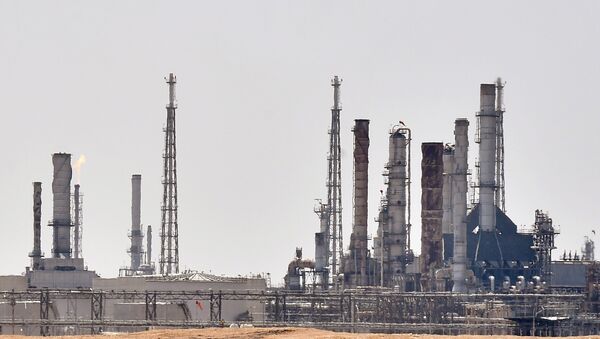A Saturday morning drone attack on two Saudi Aramco plants, in Abqaiq and Khurais, claimed since by Yemeni Houthis, sent crude prices surging.
By early Monday, US crude oil was up $4.89 per barrel, or 8.9% in electronic trading on the New York Mercantile Exchange, to $59.73 per barrel.
Brent crude, the international standard, soared $6.02 per barrel, or 10%, to $66.25 per barrel.
Earlier, US crude jumped more than 15% and Brent rocketed nearly 20%.
Although prices moderated on expectations that reserves would efficiently bridge shortfalls in output, analysts perceive a more protracted rise in oil prices as potentially damaging to the global economy.
The attack and supply disruptions are seen as particularly worrying for countries in Asia that rely heavily on Saudi oil supplies.
Two imminent risks: oil shortage and soaring prices
Francis Perrin, a senior fellow at the Rabat, Morocco-based Policy Centre for the New South and the French Institute for International & Strategic Affairs in Paris, gave his forecast of the fallout from the recent developments, saying they were extremely important for the world oil market.
“Saudi Arabia is the third-largest oil producer in the world, the largest oil exporter and the only country with a lot of spare (unused) production capacity. Saudi Arabia also controls the second-largest proven oil reserves (Venezuela is number one). This country's production was reduced by 5.7 million barrels per day (-60%) following these two attacks.”
Regarding imminent risks, Perrin singled out two: an oil shortage on the world market and much higher oil prices.
A key question to assess these two risks, says Perrin, is how much time Saudi Aramco will require to go back to its previous production level (9.6-9.7 million barrels per day).
There are three main ways to mitigate these risks, according to the expert.
Firstly, a rise in the oil production of other producing countries, whether OPEC members or not.
Secondly, the use by Saudi Arabia of some of its oil stocks to go on exporting at a high level.
And finally, a decision by the Paris-based International Energy Agency (IEA) to authorize its member states to use their strategic oil stocks.
The attacks on the two oil facilities in Saudi Arabia will complicate the plans of Saudi Arabia as far as a Saudi Aramco IPO is concerned, concluded Francis Perrin.
Donald Trump authorises use of oil from reserves
In the US, as oil prices surged Sunday, President Donald Trump said he had authorised the use of oil from the country's emergency reserve.
In a series of tweets, he said he had ordered oil from the Strategic Petroleum Reserve to be used "if needed," adding he would use enough oil "sufficient to keep the markets well-supplied."
Based on the attack on Saudi Arabia, which may have an impact on oil prices, I have authorized the release of oil from the Strategic Petroleum Reserve, if needed, in a to-be-determined amount....
— Donald J. Trump (@realDonaldTrump) September 15, 2019
The United States has more than 640 million barrels of oil in reserve that could offset the supply fallout from the attacks.
Analysts predict surge in US pump prices
US pump prices are anticipated to rise in the coming days, analysts said, as gasoline futures spiked by more than 10% on Sunday trading, reported Reuters.
The national average price of regular gasoline was currently $2.57 per gallon, according to AAA.
California motorists could be hit the hardest, with refineries in that state relying heavily on imports for supplies.
Saudi Arabia accounted for about 37 percent of California's total foreign oil imports in 2018, according to the California Energy Commission.
Among the biggest buyers of Saudi Arabian crude are Chevron Corp's 245,000-barrel-per-day (bpd) refinery in Richmond, California, and the 269,000-bpd El Segundo refinery in California.

A Chevron spokesman told Reuters the company sources crude from "multiple global suppliers", and it will "take the necessary actions to continue to meet the needs of the marketplace".
Saudi Arabia said it was working on restoring full output, but some media reports claim repair work could take weeks.
Drone attacks target Saudi Arabia’s Aramco facilities
Early on Saturday two Saudi Aramco plants - in Abqaiq and Khurais - were attacked by drones, resulting in massive fires and a suspension of the production of 5.7 million barrels of crude oil per day - more than half of Saudi Arabia's global daily exports and more than 5% of the world's daily crude oil production.
The armed Houthi political opposition faction in Yemen claimed responsibility for the attacks.
However, according to senior US officials cited by Reuters, the scope and precision of the attacks came from a west-northwest direction, suggesting that the launch was not made by the Houthis.

"There's no doubt that Iran is responsible for this. Evidence points in no other direction than that Iran was responsible for this", US officials now claim, as cited by Reuters.
US State Secretary Mike Pompeo earlier alleged that Iran had been implicated in the attacks.
Tehran rejected these allegations as false, with Iranian Foreign Minister Mohammad Javad Zarif saying on Sunday that the United States will not stop the war in Yemen - the region's poorest nation - by blaming Iran for everything.




